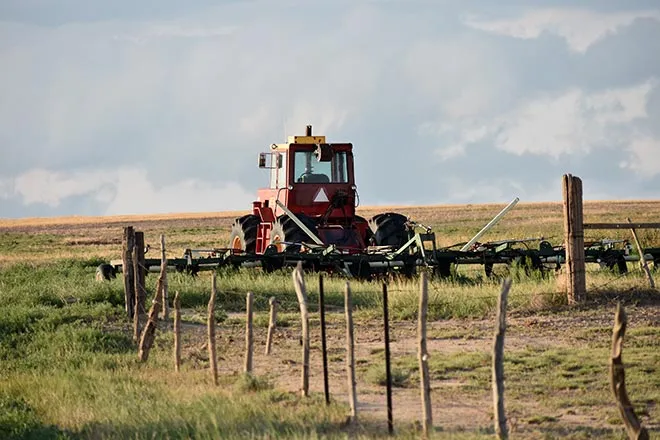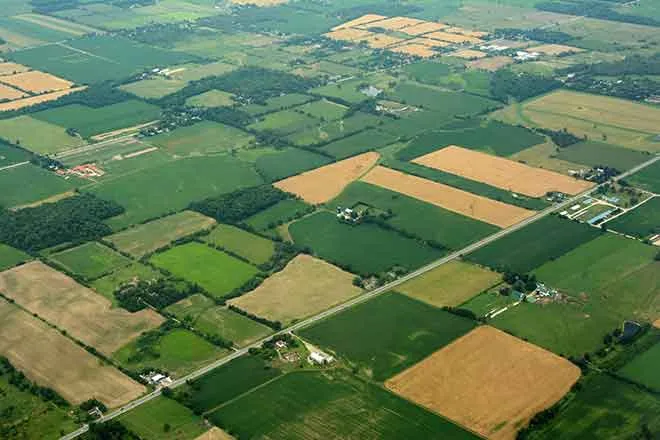
Solar leases help North Carolina farm owners up revenues, keep homestead
Click play to listen to an abbreviated version of this article.
(North Carolina News Service) Rows of photovoltaic panels glimmer placidly in the winter sun amid the fields outside Pendleton, North Carolina, a farming community in the state’s northeast Northampton County. The calming country scene is a far cry from the flooded streets of New Orleans in the aftermath of Hurricane Katrina. But that’s where Ajulo Othow, who developed the solar energy installation through her company EnerWealth Solutions, traces the roots of the project.
After Katrina hit the Gulf Coast in the summer of 2005, Othow explains, she helped to lead nonprofit economic development efforts across the region. She was struck by how many of the area’s jobs involved coal or gas production; Louisiana ships nearly two-thirds of U.S. liquified natural gas exports, for example, and New Orleans is the country’s third-busiest port for coal exports.
The carbon emissions from burning those exports, Othow knew, make extreme weather events like Hurricane Katrina more common and more powerful.

© iStock - IMNATURE
“I could see how people’s livelihoods, tied to fossil fuel extraction, basically were contributing to their own vulnerabilities,” she says. “In thinking with communities about what other economic development opportunities they had, I got very interested in renewable energy.”
Othow went to law school to learn more about the financing and regulation of solar power, and after gaining real-world experience with Strata Clean Energy in Chapel Hill, she struck out on her own with EnerWealth in 2017. Based in Oxford, North Carolina, the company’s goal is to maximize the benefits of the solar boom for rural communities.
That mission drives every facet of EnerWealth’s development approach, starting with site selection. The firm specifically seeks out Black and small-scale landowners in North and South Carolina, including farmers, who want to lease some of their property for solar panels. In return, those landowners receive a consistent stream of income that far exceeds what they would earn by leasing to other farmers.
Although some governmental and nonprofit groups, such as the National Renewable Energy Laboratory and Florida-based Black Farmers’ Collaborative, have worked to bring solar to rural communities of color, EnerWealth may be the Southeast’s only business specifically focused on that goal.
Othow admits that progress has been modest as her projects work their way through permitting and regulatory requirements. EnerWealth aims to start 100 megawatts of capacity in its development pipeline, all in rural areas, through 2024, enough to power roughly 12,000 homes; by comparison, a single solar farm installed in Northampton County to service Meta, the parent company of Facebook, generates 80 megawatts by itself.
Only two EnerWealth installations have so far been constructed, with a total capacity of just half a megawatt. The first conversations on those projects took place in 2019, and they won’t start producing power until later this year. But Othow believes the potential of her model has only begun to be tapped.
“There is a lot of opportunity to co-locate electricity production alongside agricultural production,” says Othow. “It’s a passive development model that can actually help to subsidize agricultural production and the cycles that farmers have to contend with by giving them some stable revenue over time.”
Dependable Harvest
What the EnerWealth model offers rural communities, Othow suggests, is a way to benefit from development while retaining land ownership and agricultural use. Her projects are generally smaller in scale than other agrivoltaics arrays. The Pendleton site, for example, covers just 2.6 acres of a 65-acre property, and the developments she’s seeking to start this year will range from 6 to 30 acres.
Many farming advocates have raised concerns about utility-scale solar, which can require hundreds of acres, displacing current forests and cropland. Othow hopes EnerWealth’s more distributed projects will spread opportunities more broadly while being less disruptive to farming.
Landowners agree to host EnerWealth’s solar panels for at least 35 years, earning annual payments from roughly $500 to $750 per acre. Those rates are about five to seven times higher than the $115 per acre rate that landowners earn for renting Northampton County cropland to farmers, reported by the U.S. Department of Agriculture (USDA) in 2023.
Because they’re locked in a long-term contract, solar lease payments aren’t subject to the ups and downs of the commodity crop market. And because the panels are concentrated in a single part of the farm, rather than integrated with crop production, they don’t require farmers to make big changes to their practices.
By providing a solid foundation for a diversified income portfolio, says Othow, solar leases can help landowners build wealth without having to sell their property. That’s the case for Marion Mitchell, whose family has owned the Pendleton farmland since her grandfather acquired it in the early 1900s. She remembers visiting as a little girl and later moved to live on the land herself.
Mitchell says she and her family had been leasing the property for cotton and soybean farming when the Roanoke Cooperative, the electric distribution company that partnered with EnerWealth on its first projects, approached her about installing solar panels on a small portion. The extra income was very attractive, she says, and will help her family keep the land into the future.
“I’m excited about it, because I’ve never had anything happen to me like this,” Mitchell says. “It’s something new and something different.”
Reliable income is particularly important for Black landowners such as Mitchell, who as a group have seen massive losses of land in North Carolina and across the country.
Black agricultural land ownership in the U.S. peaked in 1910 at about 16 to 19 million acres according to the USDA. But due to racially discriminatory lending practices and legal challenges over property inheritance, many of those landowners were unable to keep their property in the family over the following century. A 2022 study published in the American Economic Association’s Papers and Proceedings reckoned that Black farmers lost about $326 billion in land from 1920 through 1997.
The country’s proportion of Black farmers has also dropped precipitously since the early 20th century. While Black producers made up about 14 percent of all farmers in 1920, more than their share of the U.S. population, they represented just over 1 percent of the total in 2017, the latest year for which data is available. In North Carolina in 2017, less than 3 percent of the state’s roughly 74,000 farmers were Black, compared with over 12 percent of the general population.
Spreading Sunshine with an Electric Cooperative
By letting landowners directly profit from modest solar installations, Othow says, she has been able to overcome the skepticism that rural communities often show toward utility-scale projects, which disrupt the landscape without an obvious immediate gain for those living in the area. Because EnerWealth’s first projects were done in partnership with an electric cooperative, she can point to broader community benefits as well.
Roanoke Cooperative provides about 60 megawatts of power across six rural counties in northeast North Carolina, including Northampton. It’s a minnow compared to the state’s major electric utility, Duke Energy, the power provider for over 4.5 million people in North and South Carolina. But the organization’s size, says President and CEO Marshall Cherry, means that even small solar projects represent meaningful contributions toward its power demands.
And as a co-op, Roanoke is beholden to its customer-members, not shareholders like Duke. That means the dollars it saves by using renewable energy go directly toward reducing electricity bills.
Cherry points to the battery system placed alongside the solar panels at the Pendleton project, able to pump out 500 kilowatts for about two hours when fully charged. By charging the battery when the sun is out, then delivering power during high-demand situations like cold winter mornings, he says Roanoke can avoid buying expensive energy from the wholesale market to meet customer needs. This benefit makes the project economically viable despite its modest footprint.
“It helps us pretty much guarantee that we will have some level of reliability or capacity to operate during our peak periods,” Cherry explains. “That reduces some of our capacity purchases, thus saving dollars.”
If the co-op can reach its goal of six megawatts of battery storage, Cherry estimates the total annual savings to Roanoke’s roughly 12,000 customers at $150,000 to $200,000. With about 30 percent of those customers making less than $25,000 per year, he adds, any reduction to the power bill is welcome.
Solar development also means added jobs. In addition to her work with EnerWealth, Othow chairs the board of the nonprofit B.O.S.S.—Black Owners of Solar Services. Earlier this year, the group received a $6.3 million grant from the U.S. Department of Energy to help North Carolina’s minority- and women-owned businesses scale up and tackle renewable energy projects.
And bringing solar capital investments to rural areas, says Executive Director Matt Abele with the N.C. Sustainable Energy Association, can provide much-needed tax revenue for local governments to serve their residents.
“Solar and other renewable resources are some of the best energy solutions available to reinvest in local communities across our state and region,” Abele says. “EnerWealth Solutions has been a pioneer in developing a model that focuses on community-scale projects that reinvest in the landowners and communities that are so integral to North Carolina’s economic success.”
Clouds and Silver Linings
Although the smaller size of the EnerWealth projects theoretically makes them easier to approve, Othow says some have still run into issues that plague larger facilities. At one pilot site, local land use regulations demanded that solar be installed a substantial distance from the property boundary, a rule that had been put in place to reduce the impacts of big installations on rural communities. Taking that setback into account, there wasn’t enough space left to build the project.
“I think these zoning ordinances are not one-size-fits-all,” says Roanoke’s Cherry. “We still have some room to operate and maybe improve some of the permitting there.”
One difficulty unique to EnerWealth is the complicated landscape of ownership that’s often associated with Black farmland. Because many of the land’s first Black owners died without leaving a will or other plan for their estate, their heirs often took possession of the land without having a clear legal title of who now owned what.
This “heirs’ property” is thought to represent about a third of Black-owned land in the South, including close to $1.9 billion of land in North Carolina. Such situations can make it very difficult to identify the legally correct signer of a lease, says Othow, and when a project needs to be financed, banks often refuse to get involved if the land lacks proven ownership.
And North Carolina’s political leadership has shown some worries about farmland being used for solar power in the first place. Steve Troxler, the state’s Republican commissioner of agriculture and consumer services, says protecting agricultural land from development threats is one of his top priorities.
“As we continue to focus efforts on farmland preservation, the loss of farmland and forestland to solar panel installations remains a concern,” Troxler says. “I support farmers’ rights to do what they want with their land, but I wish we could have a do-over when it comes to solar panels, with more of a strategic placement of these installations on marginal farm and forestlands instead of prime farmland.”
But Othow believes that if landowners can benefit from having smaller solar arrays on a bit of their land, as with the EnerWealth model, they’ll be more likely to keep the rest of it in agriculture rather than sell the whole property to a developer. (She also points to a 2022 study by the North Carolina Sustainable Energy Association, which found that less than half a percent of the state’s agricultural land hosted solar panels.)
Other political trends have Othow more excited about the future. The federal Inflation Reduction Act provides additional tax credits for solar projects in low-income communities, including the areas EnerWealth is targeting, and establishes a $7 billion “Solar for All” grant fund she hopes to tap with innovative project design.
At the state level, a law signed in 2021 commits North Carolina to cutting its carbon dioxide emissions from electricity production 70 percent from 2005 levels by 2030. Othow believes solar has a critical role to play.
“This is a really good time to be in this industry,” she says. “I’m excited about the opportunities ahead for rural communities, landowners, and farmers in this space.”
Daniel Walton wrote this article for Civil Eats.

















